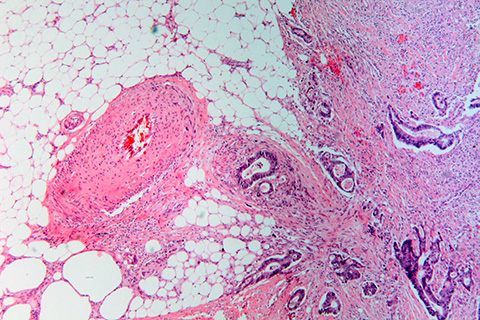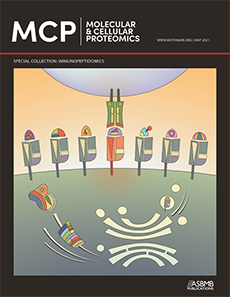From the journals: MCP
Why are two cancer drugs better than one? The glycome’s role in a malignancy. Where immunopeptidomics is going. Read about articles on these topics recently published in the journal Molecular & Cellular Proteomics.
The glycome’s role in a malignancy

Colorectal cancer, or CRC, is the leading cause of cancer death worldwide. The disease takes many forms and is difficult to diagnosis and treat. By identifying biomarkers, researchers hope to better understand CRC’s progression and find effective therapies. One clue might be provided by the covalent attachment of complex sugar molecules such as glycans. Researchers have seen that altered glycosylation can be associated with colon cancer becoming malignant.
To investigate this further, Di Wang and researchers at Leiden University Medical Center in the Netherlands analyzed the glycosphingolipid, or GSL, glycans of 22 CRC cell lines using porous graphitized carbon nano–liquid chromatography coupled with electrospray ionization–mass spectrometry.
The team found that GSL expression varies among different cell line classifications: Undifferentiated CRC cell lines were characterized by a high abundance of specific antigens that corresponded to the blood type of the person they were derived from. On the other hand, differentiated CRC cell lines contained prominent GSL glycans such as (sialyl)-LewisA/X and LewisB/Y antigens. By combining glycomics data with transcriptomic analysis, the researchers found a strong correlation between Lewis antigens in CRC cells and increased levels of glycosyltransferase FUT3 and numerous transcription factors, both of which influence colon differentiations. This could explain how GSL glycans can influence differentiation in conditions such as CRC.
This study, recently published in the journal Molecular & Cellular Proteomics, can serve as a resource for future research on biomarkers for CRC and pave the way for further studies.
Why are two cancer drugs better than one?
Two of the most often dysregulated signaling pathways in cancer are PI3K-mammalian target of rapamycin and mitogen-activated protein kinase/ERK kinase/mitogen-activated protein kinase, known as MEK/MAPK, so researchers developed inhibitors of these pathways to treat specific cancer types. However, many of these inhibitors are ineffective because downstream pathways compensate for the drugs’ anticancer activities, leading to drug resistance. This problem is being addressed by pairing synergistic therapies with both PI3K/AKT and MEK/MAPK inhibitors, but scientists have yet to understand fully why these combined treatments are more effective.
Maruan Hijazi and a team at Queen Mary University of London and the Alan Turing Institute used liquid chromatography-tandem mass spectrometry–based phosphoproteomics to learn why PI3K and MEK inhibitors work synergistically against cancer. Using cancer cell lines, they found that eukaryotic elongation factor 2 kinase, or eEF2K, a key convergence point downstream of MAPK and PI3K pathways, facilitated synergy during cotreatment with the drugs trametinib and pictilisib (which target specific MEK and PI3K kinases, respectively). Inhibitors of PI3K and MEK work together to inactivate eEF2K by phosphorylation and slowing its protein synthesis.
These studies, recently published in the journal Molecular & Cellular Proteomics, showed that eEF2K activity is a critical mediator of responses to PI3Ki plus MEKi and is a potential biomarker to predict whether combined treatment will be effective for certain cancers.
Where immunopeptidomics is going

In the 1970s, Baruj Benacarraf and Hugh McDevitt described the regulation of the immune response by the major histocompatibility complex, or MHC, a group of genes that code for proteins found on the surfaces of cells. The MHC locus is the most polymorphic region of the human genome. With this diversity, MHC molecules are able to present a wide distribution of antigen peptides to T cells, which discriminate self and nonself from many of these antigen peptides. Environmental stimuli and proteolytic enzymes in distinct cell organelles shape these antigen peptides’ biogenesis.
The isolation and characterization of these MHC-bound peptides, most commonly using liquid chromatography and mass spectrometry, is called immunopeptidomics. In an editorial introducing a special issue on immunopeptidomics in the journal Molecular & Cellular Proteomics, Pierre Thibault and Claude Perreault describe this evolving field and recent developments in immunopeptidomic workflows encompassing enrichment and labeling strategies, mass spectrometry acquisition methods, sequencing and allele prediction software. They write that challenges with current methodologies include standardization and sensitivity of the techniques.
With advances in technology, immunopeptidomics provides new opportunities for basic and applied research in immunology. Such improvements especially benefit the field of immuno-oncology, where research can improve the efficacy of immunotherapies, including therapeutic vaccines and bispecific T-cell engagers.
Enjoy reading ASBMB Today?
Become a member to receive the print edition four times a year and the digital edition monthly.
Learn moreGet the latest from ASBMB Today
Enter your email address, and we’ll send you a weekly email with recent articles, interviews and more.
Latest in Science
Science highlights or most popular articles

Bacteriophage protein could make queso fresco safer
Researchers characterized the structure and function of PlyP100, a bacteriophage protein that shows promise as a food-safe antimicrobial for preventing Listeria monocytogenes growth in fresh cheeses.

Building the blueprint to block HIV
Wesley Sundquist will present his work on the HIV capsid and revolutionary drug, Lenacapavir, at the ASBMB Annual Meeting, March 7–10, in Maryland.

Gut microbes hijack cancer pathway in high-fat diets
Researchers at the Feinstein Institutes for Medical Research found that a high-fat diet increases ammonia-producing bacteria in the gut microbiome of mice, which in turn disrupts TGF-β signaling and promotes colorectal cancer.

Mapping fentanyl’s cellular footprint
Using a new imaging method, researchers at State University of New York at Buffalo traced fentanyl’s effects inside brain immune cells, revealing how the drug alters lipid droplets, pointing to new paths for addiction diagnostics.

Designing life’s building blocks with AI
Tanja Kortemme, a professor at the University of California, San Francisco, will discuss her research using computational biology to engineer proteins at the 2026 ASBMB Annual Meeting.

Cholesterol as a novel biomarker for Fragile X syndrome
Researchers in Quebec identified lower levels of a brain cholesterol metabolite, 24-hydroxycholesterol, in patients with fragile X syndrome, a finding that could provide a simple blood-based biomarker for understanding and managing the condition.

